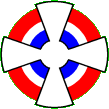|
The design of a single-seat fighter monoplane
with a braced, shoulder-mounted wing was initiated in 1932 by Ljubomir
Ilic and Kosta Sivcev. It was ordered as a private venture prototype in
1934 and built by Ikarus AD in Novi Sad. The prototype carried the designation
IK-L1 (IK comes from the surname of the first and the name of the second
designer, while L1 signifies "Lovacki 1", meaning "Fighter
One"). It was first flown on 22.04.1935. It had an all-metal construction
with fabric-skinned wings, rear fuselage and tail surfaces. The powerplant
was a Hispano Suiza 12Ycrs engine, rated at 860 hp. at 4.000 m. providing
a max. speed of 435 km/h. The radiator was located between the landing
gear. It had an excellent manouverability and it was able to climb to an
altitude of 5.000 m. within 5 minutes and 25 seconds. The first prototype
was lost in an accident on 24.04.1935 and a second prototype, designated
IK-02, was made and it first flew on 24.08.1936. It had a revised radiator
bath and a metal wing skinning, the wheel spats of found on the IK-L1 were
now removed and carried a full armament, comprised of one Hispano Suiza
HS 404 hub-mounted 20 mm. cannon and two fuselage-mounted 7,92 mm. machine
guns. The initial batch of 12 aircraft similar to IK-02, designated IK-2,
was ordered and delivered early in 1939. Because the design was considered
to be obsolete, no further aircraft were built. The Ikarus IK-2 was the
first fighter designed in Yugoslavia.
The IK-2 fighters were operationally used by one squadron of the 40th
fighter wing (40ti Lovacki Puk) of the VVKJ (Vazduhoplovstvo Vojske Kraljevine
Jugoslavije - AF of the Yugoslav Royal Army). They were painted silver-grey,
and had the normal national markings on both sides of the wings and with
a blue-white-red tricolour on the vertical stabiliser. Over the tricolour
the type, weight, serial number of the aircraft and the type of engine
were written (similar to the practise in the French AF). These aircraft
were used in the defence of the country during the April 1941 attack and
fought well against the German opponents. Few were captured by the Germans
and given to the AF of the newly created Croatian state, known as NDH (Nezavisna
Drzava Hrvatska - Croatian Independent State). They were subsequently destroyed
during the war.
|
Technical information |
 Ikarus
Ik-2
Ikarus
Ik-2 Ikarus
Ik-2
Ikarus
Ik-2